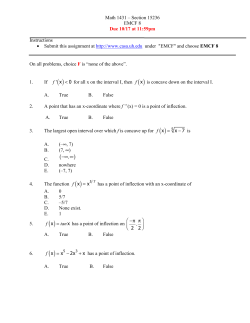
Math 3339
Math 3339 Section 19377 MWF 10-11am SR 116 (and section 20582 – online) Bekki George bekki@math.uh.edu 639 PGH Office Hours: 11:00 - 11:45am MWF or by appointment Thursday online 5-7 pm EMCF 24 1. Suppose a test of the hypotheses produces a P-value of 0.11. The correct action would be to a. Reject Ho b. Accept Ho c. Fail to reject Ho d. Accept Ha 2. In general, exactly what does the P-value measure or what does it tell us? a. The probability that Ho is true b. The probability that Ha is true c. The probability that Ho is true given that the sample data is what is given d. The probability that Ha is true given that the sample data is what is given e. None of these Section 9.1 – Z – Tests and Confidence Intervals for a Difference Between Two Population Means Confidence Intervals for µ1 – µ2 Suppose we have two populations and we wish to compare their means. In order to estimate µ1 − µ2 , we take random samples of size n1 and n2 from populations 1 and 2 respectively. If population one has sample mean x , sample standard deviation σ 1 , and sample size n1 , and population two has sample mean y , sample deviation σ 2 , and sample size n2 , then a (1− α )100 percent confidence interval for µ1 − µ2 is ⎡ σ 12 σ 2 2 σ 12 σ 2 2 ⎤ + , ( x − y ) + zα /2 + ⎢( x − y ) − zα /2 ⎥ n1 n2 n1 n2 ⎥⎦ ⎢⎣ Example: The analysis of the breaking strength (in pounds per square inch) of n1 = 35 specimens of a certain all synthetic fabric A led to the mean 25.2 psi and standard deviation 5.2 psi. A similar analysis of n2 = 30 specimens of fabric B (which includes some cotton) resulted in a mean of 28.5 psi and a standard deviation of 5.9 psi. Determine a 95% confidence interval for µ1 − µ2 , the difference between the two population means. For Hypothesis Testing of µ1 – µ2, the test statistic is z= z= t= x− y s12 s22 + n1 n2 If population s.d. unknown and each n > 30, or x− y σ 12 σ 22 + n1 n2 If population s.d.known, or x− y s12 s22 + n1 n2 If at least one n < 30. 2 ⎛s s ⎞ ⎜n +n ⎟ ⎝ 1 2⎠ df = 2 and round down to nearest integer 2 2 2 (s1 / n1 ) (s2 / n2 ) + n1 − 1 n2 − 1 2 1 2 2 a more simple but less accurate calculation for df is n1 + n2 − 2 Ex: Analysis of a random sample consisting of 20 specimens of cold-rolled steel to determine yield strengths resulted in a sample average strength of 29.8 ksi. A second random sample of 25 two-sided galvanized steel specimens gave a sample average strength of 34.7 ksi. Assuming that the two yield-strength distributions are normal with population standard deviations of 4.0 ksi (for cold-rolled) and 5.0 ksi (for two-sided galvanized). Does the date indicate that the corresponding true average yield strengths of the two methods are different? (Use 0.01 significance level) Section 9.2 - The Two Sample t – Test and Confidence Interval Confidence Intervals for µ1 – µ2 (small sample sizes) Determine a 95% CI for the difference in mean. EMCF 24 3. In the P-‐value approach to hypothesis testing, if the P-‐value is less than a specified significance level, we fail to reject the null hypothesis. a. True b. False 4. The larger the level of confidence, the shorter the confidence interval. a. True b. False 5. The best point estimate for the population mean is the sample mean. a. True b. False
© Copyright 2025





















